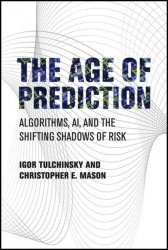The Age of Prediction: Algorithms, AI, and the Shifting Shadows of Risk
- Добавил: literator
- Дата: 29-08-2023, 17:18
- Комментариев: 0
 Название: The Age of Prediction: Algorithms, AI, and the Shifting Shadows of Risk
Название: The Age of Prediction: Algorithms, AI, and the Shifting Shadows of RiskАвтор: Igor Tulchinsky, Christopher E. Mason
Издательство: The MIT Press
Год: 2023
Страниц: 248
Язык: английский
Формат: pdf , epub, mobi
Размер: 10.1 MB
The power of the ever-increasing tools and algorithms for prediction and their paradoxical effects on risk.
The Age of Prediction is about two powerful, and symbiotic, trends: the rapid development and use of Artificial Intelligence (AI) and Big Data to enhance prediction, as well as the often paradoxical effects of these better predictions on our understanding of risk and the ways we live. Beginning with dramatic advances in quantitative investing and precision medicine, this book explores how predictive technology is quietly reshaping our world in fundamental ways, from crime fighting and warfare to monitoring individual health and elections.
As prediction grows more robust, it also alters the nature of the accompanying risk, setting up unintended and unexpected consequences. The Age of Prediction details how predictive certainties can bring about complacency or even an increase in risks—genomic analysis might lead to unhealthier lifestyles or a GPS might encourage less attentive driving. With greater predictability also comes a degree of mystery, and the authors ask how narrower risks might affect markets, insurance, or risk tolerance generally. Can we ever reduce risk to zero? Should we even try? This book lays an intriguing groundwork for answering these fundamental questions and maps out the latest tools and technologies that power these projections into the future, sometimes using novel, cross-disciplinary tools to map out cancer growth, people’s medical risks, and stock dynamics.
Humanity has entered a new era. We are now living in a world that is increasingly wired by billions of predictive algorithms, a world in which almost everything can be predicted and risk and uncertainty appear to be diminishing in almost all areas of life. We call this new era the Age of Prediction. In this emerging age, prediction is growing more powerful, ubiquitous, and precise, both because the tools for making predictions are advancing quickly and because the fuel of prediction—data—is accumulating at such a rapid and exponential (sometimes super-exponential) rate. Yet, none of this is easy. When it comes to many natural processes, we have grown more and more quantitative—and thus more predictive.
Algorithms are computer code, instructions that send an input through a finite number of steps to produce some sort of output. Algorithms are predictive models of data. A financial algorithm attempts to predict the movement of a stock, bond, commodity, or derivative price; macro- and microeconomic data; intrinsic values; or the state of dynamic relationships between financial instruments and data. An algorithm can establish either a correlation between two data points (if one increases, another rises in tandem), an inverse correlation (one data point falls, driving up another point, thus providing a hedge), or other nonlinear relationships. Algorithms can produce strong or weak signals or die out entirely. In their totality, algorithms resemble a vast array of sensors responsive to a diverse and profoundly complex flowing stream of signals.
Скачать The Age of Prediction: Algorithms, AI, and the Shifting Shadows of Risk
Внимание
Уважаемый посетитель, Вы зашли на сайт как незарегистрированный пользователь.
Мы рекомендуем Вам зарегистрироваться либо войти на сайт под своим именем.
Уважаемый посетитель, Вы зашли на сайт как незарегистрированный пользователь.
Мы рекомендуем Вам зарегистрироваться либо войти на сайт под своим именем.
Информация
Посетители, находящиеся в группе Гости, не могут оставлять комментарии к данной публикации.
Посетители, находящиеся в группе Гости, не могут оставлять комментарии к данной публикации.
